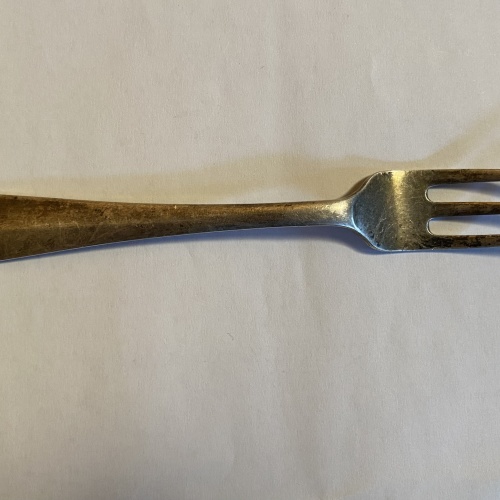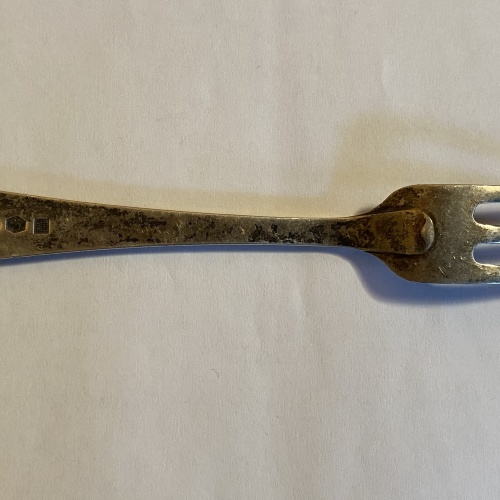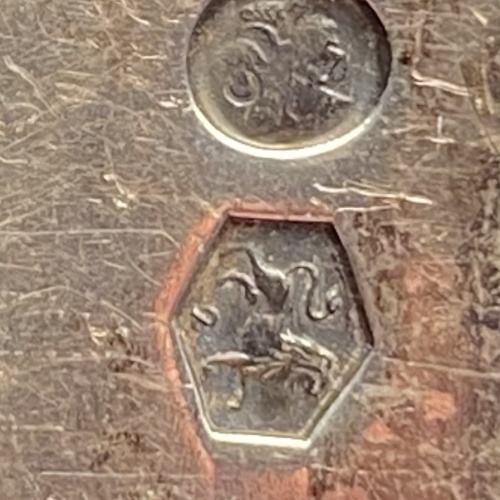Hello everyone,
Please help me to identify following fork
Best wishes
https://tinypic.host/image/IMG-5127.DIA7h
Fork to id
Re: Fork to id
Hi,

Dutch hallmarks, top to bottom;
HEO above table, responsibility mark of H.E. Oving Bz, registered in the Dutch city of Groningen, 1905- 1955, Dutch standard mark, lion passant above 2, second standard silver 833/000, used 1814-1953, Assay office mark, or Minerva head, regional assay office letter E for Groningen, year letter X for 1907.
https://www.beeldbankgroningen.nl/beeld ... 10254d71ff
Peter.

Dutch hallmarks, top to bottom;
HEO above table, responsibility mark of H.E. Oving Bz, registered in the Dutch city of Groningen, 1905- 1955, Dutch standard mark, lion passant above 2, second standard silver 833/000, used 1814-1953, Assay office mark, or Minerva head, regional assay office letter E for Groningen, year letter X for 1907.
https://www.beeldbankgroningen.nl/beeld ... 10254d71ff
Peter.
Re: Fork to id
::::: Does anyone know more about the history of 3-tined dinner forks in The Netherlands? ::::: I
:::::: I've noticed these larger 3-tined dinner forks from The Netherlands ever since I bought one many years ago. ::::::
:::::::::: There are instances of other 3-tined dinner forks, such as the Colonial Williamsburg dinner forks from the American Company Stieff, but those forks are sort of an homage to an earlier "Queen Anne" style of fork so the 3-times is more like a historical detail. :::: The CJ Vander Company has an English Onslow pattern with 3-tines and an Onslow scroll style on the handle, but again this hearkens back to an earlier time and is more like a historical homage to cutlery of the past. :::::::::
:::::::: In the case of these 3-tined dinner forks from The Netherlands, it seems like these forks are not part of a historical line, it doesn't seem like an homage to the past, it seems more like a normal occurrence in silver from The Netherlands to have a 3-tined dinner fork and it's just totally normal, no big deal, no historical significance, just a totally normal dinner fork that was made in the late 19th/early 20th century and it just happens to have 3-tines. ::::::
:::::: Maybe these forks are homages to Queen-Anne 3-tined Hanoverian forks and the Dutch were actually making these as an homage, but if there is some greater significance here I would be interested to know, kind of like how the Dutch Pea Strainer is very specific to Dutch culinary culture, these 3-tined dinner forks might have some sort of specific purpose for a specific Dutch cuisine, something that you would specifically need a 3-tined for for? :::::::
:::::: I've noticed these larger 3-tined dinner forks from The Netherlands ever since I bought one many years ago. ::::::
:::::::::: There are instances of other 3-tined dinner forks, such as the Colonial Williamsburg dinner forks from the American Company Stieff, but those forks are sort of an homage to an earlier "Queen Anne" style of fork so the 3-times is more like a historical detail. :::: The CJ Vander Company has an English Onslow pattern with 3-tines and an Onslow scroll style on the handle, but again this hearkens back to an earlier time and is more like a historical homage to cutlery of the past. :::::::::
:::::::: In the case of these 3-tined dinner forks from The Netherlands, it seems like these forks are not part of a historical line, it doesn't seem like an homage to the past, it seems more like a normal occurrence in silver from The Netherlands to have a 3-tined dinner fork and it's just totally normal, no big deal, no historical significance, just a totally normal dinner fork that was made in the late 19th/early 20th century and it just happens to have 3-tines. ::::::
:::::: Maybe these forks are homages to Queen-Anne 3-tined Hanoverian forks and the Dutch were actually making these as an homage, but if there is some greater significance here I would be interested to know, kind of like how the Dutch Pea Strainer is very specific to Dutch culinary culture, these 3-tined dinner forks might have some sort of specific purpose for a specific Dutch cuisine, something that you would specifically need a 3-tined for for? :::::::
Re: Fork to id
A fork is a piece of cutlery and consists of a handle with a number of prongs attached to it (usually three or four). A fork is mainly used when cutting food: to keep it in place. And to bring cut pieces to the mouth. Furthermore, the function of the fork partially overlaps that of the spoon: a lot of food can be brought to the mouth with both a spoon and a fork.
See;
https://www.925-1000.com/forum/viewtopi ... 65#p212865
Peter.
See;
https://www.925-1000.com/forum/viewtopi ... 65#p212865
Peter.
Re: Fork to id
::::: These Dutch forks with 3-tines that measure between 6 and 7 inches in length have been described as "dessert forks" so maybe this type of fork could be used as either a cake fork (with very sturdy outer tines that could easily break slices of cake and pastries) or it could be used as a berry fork (similar to strawberry forks with 3-tines) if so needed as well. ::::::
:::::: Seems a bit large for dessert forks, but that's all the information I have right now. ::::::
:::::: So I guess these are dessert forks, unless there is a helpful comment from someone else. ::::::
:::::: Seems a bit large for dessert forks, but that's all the information I have right now. ::::::
:::::: So I guess these are dessert forks, unless there is a helpful comment from someone else. ::::::
Re: Fork to id
The 18th century cutlery were all the same length; about 20 cm long.
This changed in the course of the 19th century.

There will be a “large cutlery set” and a “small cutlery set”. A large cutlery set consists of a spoon with a matching fork that is about 20-22 cm long. This was used with the hot meal. A small cutlery set is used for sandwiches or desserts; spoon with a matching three tined fork, that is about 18 – 19.5 cm long. With the explosion of cutlery for every possible specific use at the end of the 19th century; children's cutlery, fruit cutlery, etc

Fruit cutlery set. This set is particularly recognisable because of the size: the knife is about 17 cm long, and the fork ( three tines) only about 15 cm. A mini silver cutlery set. This fruit cutlery set was made by the Dutch silver factory Gerritsen and van Kempen in Zeist. The 2nd grade silver handles are in the Art Deco model "203", with a hammered handle that ends in a daisy. The teeth of the fork and the blade of the knife are made of stainless steel. Fruit cutlery was almost never completely made of silver because fruit acids can stain silver.
Source;
Blog Zilver.nl | Old Memories | Zilver.nl |
Peter.
This changed in the course of the 19th century.

There will be a “large cutlery set” and a “small cutlery set”. A large cutlery set consists of a spoon with a matching fork that is about 20-22 cm long. This was used with the hot meal. A small cutlery set is used for sandwiches or desserts; spoon with a matching three tined fork, that is about 18 – 19.5 cm long. With the explosion of cutlery for every possible specific use at the end of the 19th century; children's cutlery, fruit cutlery, etc

Fruit cutlery set. This set is particularly recognisable because of the size: the knife is about 17 cm long, and the fork ( three tines) only about 15 cm. A mini silver cutlery set. This fruit cutlery set was made by the Dutch silver factory Gerritsen and van Kempen in Zeist. The 2nd grade silver handles are in the Art Deco model "203", with a hammered handle that ends in a daisy. The teeth of the fork and the blade of the knife are made of stainless steel. Fruit cutlery was almost never completely made of silver because fruit acids can stain silver.
Source;
Blog Zilver.nl | Old Memories | Zilver.nl |
Peter.
Re: Fork to id
:::::: Small cutlery set for sandwiches and desserts makes a lot of sense, it's really a great 3-tined fork design that has sharp tines that is great for olives/pickles if necessary, thanks for the information, now I finally understand the Dutch tradition of large and small cutlery sets, thanks. ::::::::
 [/URL]
[/URL] 
